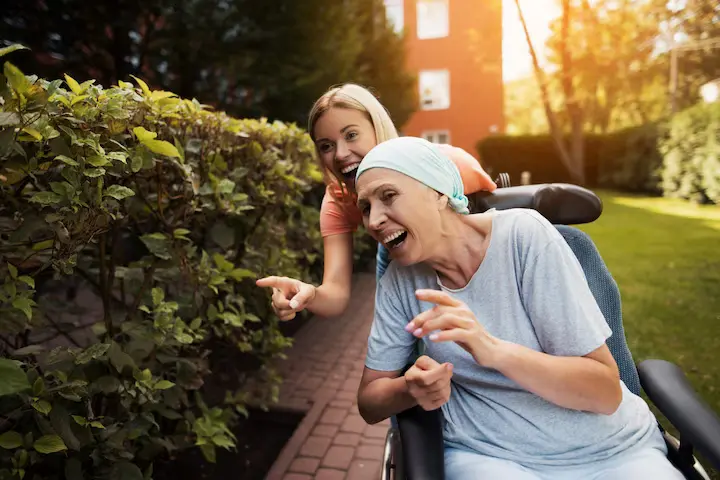Caretaker vs Caregiver | 10 Key Differences and Roles

- Caretaker vs Caregiver
- Caretaker vs Caregiver: 10 Key Differences
- Caregiver Duties and Responsibilities
- Caretaker Duties or Roles
- Caregiver Salary and Benefits
- Caretaker Salary and Benefits
- How to Become a Caretaker?
- How to Become a Caregiver?
- Conclusion: Caretaker vs Caregiver
- Frequently Asked Questions (FAQs)
- References
This post may contain affiliate links, meaning I may earn a commission if you make a purchase, at no extra cost to you. I only recommend products I trust. Thank you for your support.
Deciphering the roles of a caretaker vs caregiver unveils a world of difference in responsibilities and skills, despite the apparent similarity in their designations.
Caretaking generally involves the maintenance, management, and preservation of a property, environment, or non-living entity whereas caregiving involves providing physical, emotional, and often medical support to individuals who are in need of assistance due to illness, disability, or age-related challenges.
This distinction underlines the varied nature of each role, emphasizing the caregiver’s focus on emotional and personal care versus the caretaker’s emphasis on practical, day-to-day tasks and maintenance [1].
Understanding the nuances between caretaker vs caregiver, as well as caregiving vs caretaking, is crucial for anyone looking to fulfill either role effectively.
This article aims to explore the key differences, roles, and responsibilities associated with each, delving into aspects such as how to become a caretaker, the complexities of caregiving, and what remunerations both roles can expect.
Furthermore, it addresses the important question of choosing the right type of support based on the needs of those requiring care [2].
Caretaker vs Caregiver
A caretaker typically refers to someone who is responsible for looking after a property, such as a house or a piece of land whereas a caregiver is someone who provides care and support to another individual, often in a health-related or personal capacity.
Caretakers often work in settings such as residential properties, estates, parks, or vacation homes while Caregivers are commonly employed in hospitals, nursing homes, and assisted living facilities and private homes.

Caretaker vs Caregiver: 10 Key Differences
These differences illustrate the varied roles and responsibilities of caretakers and caregivers, highlighting the distinct nature of their work and the focus of their care.
1. Focus of Responsibility
- A caretaker is responsible for the maintenance and management of property or physical assets.
- A caregiver is responsible for providing physical, emotional, or medical care to individuals.
2. Nature of Care
- Caretakers focus on maintaining and preserving physical assets.
- Caregivers focus on the well-being and comfort of individuals.
3. Recipient of Care
- Caretakers care for property or non-living entities.
- Caregivers care for individuals who require assistance due to illness, disability, or age-related challenges.
4. Activities
- Caretakers may perform tasks related to property maintenance, security, and administrative oversight.
- Caregivers may assist with activities of daily living, provide emotional support, administer medication, and arrange medical appointments.
5. Professional Roles
- Caretakers can include property managers, maintenance staff, or those responsible for overseeing estates.
- Caregivers can include nurses, home health aides, personal care assistants, and family members providing care to loved ones.
6. Work Setting
- Caretaking often occurs in the context of property management, real estate, or land maintenance.
- Caregiving often occurs in healthcare facilities, nursing homes, home care settings, or when providing support to family members.
7. Emotional Support
- Caretakers may not typically provide extensive emotional support to property or physical assets.
- Caregivers often provide significant emotional support to individuals in their care.
8. Medical Care
- Caretakers do not typically provide medical care or assistance.
- Caregivers may provide medical care, administer medication, and assist with healthcare needs.
9. Daily Tasks
- Caretakers focus on tasks related to the physical maintenance and security of property.
- Caregivers focus on assisting with personal care, mobility, and other daily needs of individuals.
10. Duration of Care
- Caretaking responsibilities may be ongoing but are often project-based or related to specific timelines.
- Caregiving can involve long-term, continuous care for individuals who have ongoing health or personal care needs.
Caregiver Duties and Responsibilities
Caregivers play a pivotal role in enhancing the quality of life for those under their care, offering a wide range of support that spans from basic personal care to emotional companionship and coordination with healthcare professionals.
Caregiver duties can be broadly categorized into three main areas namely;

1. Personal Care and Daily Living Support:
- Assisting with activities of daily living (ADLs) such as bathing, grooming, dressing, and ensuring mobility. This includes helping individuals get in and out of wheelchairs, cars, and managing toileting needs [3].
- Managing household tasks that the person under care may find challenging. This encompasses meal preparation, light housekeeping, doing laundry, and running errands.
- Providing general health care oversight by administering medications, ensuring they are taken on time and in the correct dosage, and offering reminders for appointments and medication schedules.
2. Emotional Support and Companionship:
- Offering constant companionship, which involves engaging in conversations, providing a listening ear, participating in activities together, and being a stable companion and supporter in all matters personal, health-related, and emotional [4].
- Ensuring the individual feels valued and supported, enhancing their emotional and psychological well-being, and promoting independence whenever feasible.
3. Coordination and Health Monitoring:
- Coordinating medical appointments and communicating effectively with healthcare professionals to ensure a cohesive care plan is followed.
- Monitoring the health conditions of the individual, noticing any changes in their health, and recording and reporting any differences to healthcare providers or family members.
- Employing specialized knowledge in areas such as the prevention of pressure ulcers, managing incontinence, and understanding the best practices for bathing and skin care.
Caretaker Duties or Roles
Caretakers play an integral role in managing properties, or caring for animals, and performing essential tasks that contribute to safety, cleanliness, and overall property management.
Caretaker duties can be categorized into several key areas namely;
1. Property Maintenance
- Conducting regular inspections to identify and address maintenance needs such as plumbing, electrical, and structural issues.
- Performing repairs or coordinating with contractors for more extensive maintenance work.
- Lawn care, landscaping, and ensuring the overall aesthetic appeal of the property.
- Keeping the property clean and well-maintained, including regular cleaning of common areas, restrooms, and other facilities.
2. Security and Safety
- Overseeing security systems and conducting regular patrols to ensure the safety and security of the property.
- Developing and implementing emergency response plans for various situations, such as fires, natural disasters, or medical emergencies.
- Monitoring for any unauthorized activity, potential hazards, or safety concerns.
3. Administrative Oversight
- Maintaining records of property maintenance, repairs, and inspections.
- Liaising with property owners, tenants, or relevant authorities to address concerns and coordinate necessary actions.
- Managing documentation related to tenants, visitors, or animal care records.
4. Animal Care (If Applicable)
- Providing proper nutrition and feeding schedules for animals under their care.
- Ensuring animals have adequate shelter, bedding, and living conditions that promote their comfort and well-being.
- Monitoring the health and well-being of animals through their feeding habits.
- Maintaining cleanliness in animal housing areas to prevent the spread of disease and ensure a safe environment.
Caregiver Salary and Benefits
Caregiver salary vary widely across the United States, influenced by factors such as location, experience, and whether the caregiver is providing medical or non-medical care.
Here’s a breakdown of a caregiver salary and benefits
- The average monthly salary for a caregiver in the U.S. is approximately $2,692, with a range typically falling between $2,375 and $3,000.
- Hourly wages for caregivers vary, with an average ranging from $10 to $15. However, specialized caregivers such as Certified Nursing Aides (C.N.A.’s) and Certified Home Health Aides (C.H.H.A.’s) can earn between $10 to $16 per hour.
- Illinois emerges as the top-paying state for caregivers, with an average monthly income of $3,682, followed by high-paying cities like Cupertino, CA, and San Mateo County, CA. Chicago, IL, specifically, offers an average monthly salary of $2,774 for caregivers.
- Besides their basic salary, caregivers may also receive benefits such as health insurance, retirement plans, and paid time off, contributing to their overall compensation package.
- For Full Time Live In Caregivers, annual salaries can reach up to $46,742 nationally. Cities like San Francisco, CA, and San Jose, CA, are among the top 10 highest paying for this role.
- Specialized caregiving roles such as Regional Caregiver and Caregiver Manager command higher salaries, with annual earnings of $105,645 and $59,525 respectively.
Caretaker Salary and Benefits
Understanding the financial landscape for caretakers in the United States requires a look at various factors, including hourly wages, annual salaries, and the benefits that accompany these roles.
Here’s a comprehensive breakdown of a caretaker salary and benefits:
- The average hourly pay for caretakers ranges significantly, from $10.34 at the lowest to $33.65 at the highest, with an average rate of $20.34.
- Caretakers in the 25th percentile earn about $16.35 per hour, while those in the 75th percentile make approximately $23.80 per hour.
- Annual salary figures show a broad spectrum too, with the average salary for a caretaker being $45,350, and the estimated total pay, including additional benefits, reaching around $49,681.
- Besides their hourly or annual pay, caretakers often receive valuable benefits such as health insurance, retirement plans, and paid time off, enhancing the overall compensation package.
- A notable non-cash benefit includes access to 401(k) plans, providing a pathway for caretakers to save for retirement.
- The caretaker job market is notably active in certain areas, with Chicago, IL, offering an average pay of $21 per hour, ranking it number 1 out of 50 states nationwide for caretaker salaries.
- High-paying cities for caretaker roles include Sunnyvale, CA, and Arlington, VA, with hourly wages up to $25.64, showcasing the geographical variance in compensation.
How to Become a Caretaker?
To become a caretaker, individuals can pursue several pathways that involve a combination of education, skills development, and practical experience.
The specific steps to become a caretaker can vary based on the type of caretaking role, such as property caretaker, animal caretaker.
Here are general guidelines for becoming a caretaker:
Education and Training
- Obtain a High School Diploma or equivalent since most caretaking positions require at least a high school diploma or GED.
- Consider obtaining certifications that are relevant to the type of caretaking role. For example, property management certifications may be beneficial for those focused on property maintenance.
Gain Practical Experience
- Look for opportunities to gain hands-on experience in caretaking roles. This can include internships, volunteer work, or entry-level positions in property maintenance, animal care facilities..
- Cultivate practical skills such as basic plumbing, electrical work, landscaping, and general maintenance, which are valuable for property caretakers.
Legal and Regulatory Knowledge
- Familiarize yourself with local laws and regulations related to property management or animal care, depending on the specific caretaking role.
Continued Professional Development
- Keep abreast of best practices, safety protocols, and relevant industry developments through continued education and training programs.
Explore Specialized Areas
- For individuals interested in animal caretaking, consider gaining knowledge and experience in the specific needs of these areas, such as animal behavior, health, and welfare for animal caretakers.
How to Become a Caregiver?
To become a caregiver, individuals can pursue several pathways that involve a combination of education, skills development, and practical experience.

Here are general guidelines for becoming a caregiver:
Education and Training
- While a high school diploma or equivalent is the minimum requirement for some caregiver roles, pursuing formal education in fields such as nursing programs, healthcare, or social work can enhance your qualifications.
- Consider enrolling in caregiver training programs offered by community colleges, vocational schools, or healthcare organizations. These programs provide valuable education on caregiving techniques, medical assistance, and ethical considerations.
- Depending on the requirements in your area, consider obtaining certifications such as Certified Nursing Assistant (CNA) or Home Health Aide (HHA) certification, which can enhance your credentials as a caregiver.
Gain Practical Experience
- Look for opportunities to gain practical experience through internships, volunteer work, or entry-level positions in healthcare facilities, home care agencies, or assisted living facilities.
- Caregiving requires strong interpersonal skills, empathy, and compassion. Work on developing these qualities to effectively support and connect with the individuals under your care.
Continued Professional Development
- Keep up-to-date with advancements in caregiving, healthcare practices, and relevant industry developments through continued education and training programs.
- To stay current with caregiving practices, caregivers are required to undertake 12 hours of in-service training every 12 months.
Specialized Areas
- Consider specializing in areas such as elderly care, disability care, pediatric care, or mental health caregiving, depending on your interests and career goals.
- For individuals seeking to advance their careers in caregiving, pursuing further education in nursing, social work, or related fields can open up opportunities for more specialized roles.
Conclusion: Caretaker vs Caregiver
Navigating the journey of selecting appropriate support for those in need, whether it be due to aging, illness, or disability, requires a fundamental understanding of the distinct roles and contributions of a caretaker vs caregiver.
This article has provided a comprehensive exploration of their respective responsibilities, salary, training as well as practical support they offer, aiming to clarify the differences.
While caretakers provide professional assistance with daily activities and focus on the physical aspects of care, caregivers offer emotional support and companionship to their loved ones.
Both roles require unique qualifications, training, and responsibilities. By recognizing the distinctions between caregiver vs caretaker, individuals can make informed decisions and ensure the best possible care for their loved ones.
In conclusion, while both caretakers and caregivers play crucial roles in providing care and support, their areas of focus and responsibilities are distinct.
Check out these trending articles:
- Top 10 countries for caregivers
- 1600 high protein calorie meal plan
- 7-day 1400 calorie meal plan
- Is celery safe for dogs?
- Pediatric nurse salary
- Nurse anesthetist salary
- 7-day 1400 calorie meal plan
- Life expectancy with fatty liver disease
- 11 health benefits of green bananas
- How much do physical therapists make?
- Developmental delays vs autism
- Best childcare centers in your area
- Canada vs USA: Which is the best country for caregivers?
- 15 Caregiver coping strategies
Frequently Asked Questions (FAQs)
What is a caretaker?
A caretaker is an individual responsible for the maintenance, management, and general oversight of properties, physical assets, or animals.
What is the difference a caregiver and caretaker?
The primary distinction lies in their responsibilities. A caregiver primarily provides physical or medical care, emotional support, and assistance with daily living activities to individuals who require help due to illness, disability, or age-related challenges. In contrast, a caretaker is responsible for the maintenance, upkeep, and daily operational tasks of properties or buildings and sometimes animals.
How do caregiver and caretaker relationships differ?
Caretaking typically refers to a professional, paid role centered on ensuring the safety, health, and well-being of another person. Conversely, caregiving is usually an unpaid, voluntary role undertaken by family members or friends, motivated by love and a commitment to the person in need.
Caretaking Vs Caregiving
Caretaking generally involves the maintenance, management, and preservation of a property, environment, or non-living entity, whereas caregiving on the other hand involves providing physical, emotional, and often medical support to individuals who are in need of assistance due to illness, disability, or age-related challenges.
What responsibilities does a caretaker have?
Caretakers are tasked with the maintenance and security of the properties or buildings under their charge. Their duties include overseeing the property’s assets, monitoring security systems, and ensuring the premises remain clean and well-maintained.
How much does a caretaker make?
The average hourly salary for caretakers is $20.34 ranging between $10.34 and $33.65. The salary of a caretaker can vary depending on factors such as qualifications, experience, location, and job requirements.
How do I choose between a caretaker and a caregiver?
Factors such as the care recipient’s specific needs, the availability of family support, financial considerations, and the desired level of involvement should be taken into account when choosing between a caretaker and a caregiver. In some cases, a combination of both may be the most suitable option.




